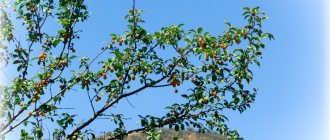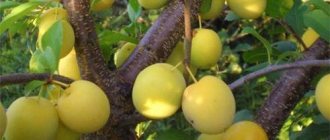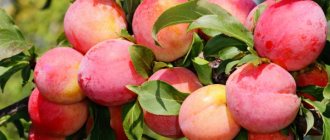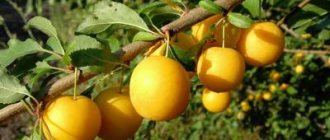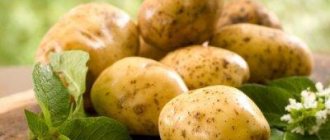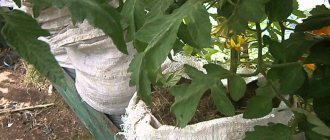Cherry plum is not as common an inhabitant of garden plots in central Russia as the plum. Probably because it seems to most gardeners to be a creature adapted to southern latitudes, and besides, it also requires more care, and therefore is associated with greater difficulties in growing. But all this is no longer the case, and through the efforts of Soviet breeders, many varieties have already been developed that are capable of growing well and producing significant harvests in areas where winters are longer and colder than in the south. One such striking example is the Kuban Comet variety.
Description of the variety
The Kuban Comet variety is part of the group of so-called “Russian plums”. This name unites several dozen hybrids that began to be bred back in the 60s of the 20th century at the Crimean Experimental Station. Most often, the Chinese plum, which was characterized by its low height and high yield, was used as one of the “parents”. So in this case, when creating the Kuban Comet variety, the Pioneer cherry plum was crossed with the Chinese early-fruiting plum. The result was a tree that produces an early and, moreover, rich harvest, capable of living in cold winter conditions. That is why in 1987 the variety was zoned not only for the Lower Volga and North Caucasus regions, but also for the Central and Northwestern regions.
The fruits of the Kuban comet are large and grow in large quantities
As one would expect, the Kuban comet tree does not grow tall (does not exceed three meters). The crown is quite sparse, rounded and at the same time flattened. The bark on the trunk, as well as on the branches, is gray and smooth. Interestingly, it brightens on the sunny side. The round flower buds are small in size and gradually turn pink as the scales bloom.
The Kuban Comet tree is very short, but during fruiting it is covered with fruits
During development, medium-sized leaves usually elongate and grow vertically, and their tips become pointed. They seem to be covered with gloss and have a rich green color. The edges are slightly wavy and slightly serrated. The flowers are medium in size and white. One bud produces two flowers, and during flowering the cherry plum looks very elegant, so it is often used as an element of landscape design.
The fruits are quite large, weight can reach 45 g, oblong. A faint ventral suture can be found on them. The skin is dense, burgundy, as if covered with wax. The pulp is quite dense, orange, with a fibrous structure and very juicy. With a sweet and sour taste, however, it has a weak aroma. It has a high rating on a five-point tasting scale - 4.6.
Video: review of the Russian plum Kuban comet
Cherry plum Kuban comet: reviews from those who grow
Maria, 45 years old, Kuban This winter in our region there was an unusually cold winter - frosts reached -30 degrees Celsius. As a result, this cherry plum froze and did not bloom in the spring, because the flower buds also died. But during the season the tree recovered, I hope that next season the fruiting will be abundant, as before.
Mikhail, 50 years old, Volgograd region. On my plot there are two cherry plum trees of the Kuban Comet variety. They bear fruit every year, we collect 12-14 buckets of ripe fruits annually. All my friends who have tried this cherry plum graft cuttings from my trees onto their trees. The first fruit tree grows in a sunny area, and its fruits have practically no sourness, they are sweet and juicy, so my wife makes jam from them, and I make liqueur. And the second tree, it so happened that over the years it ended up in the shadow of taller apple trees. And the fruits on it are more sour, so we use them to prepare sauce for the winter.
Cherry plum Kuban comet - a high-yielding variety, with stable regular fruiting, low-growing, winter-hardy
. The first harvest from the tree is harvested a couple of years after planting. These fruit trees do not require special care and bear fruit well in sandy, fertile soils. However, this cherry plum is practically sterile, so other varieties of cherry plum should be planted nearby for cross-pollination.
Recently searched:
cherry plum Kuban Comet reviews, description of the cherry plum variety Kuban Comet, productivity of the Kuban Comet, cherry plum Kuban Comet planting and care
Advantages and disadvantages
The main advantage of the Kuban Comet, according to gardeners, is the rich and stable yield of the crop. Even with little care, this tree gives good results, which only adds to its attractiveness. The fruits of this variety are large and beautiful. This is the case when both the appearance and the internal content perfectly correspond to each other.
The variety has good winter hardiness. Without it, he would not have been able to take root, particularly in the North-West region, where summers are often colder than in the south of the country, and winters are colder.
Another serious advantage of the Kuban Comet is that its fruits do not crack when ripe, do not fall off, and due to their good density, they can easily withstand transportation.
Blooming cherry plum is always a decoration of the garden
The disadvantages of the variety are not so noticeable and can be easily eliminated with the right approach. For example, regular and proper pruning allows you to avoid thickening the crown and shredding of fruits when there is an excess of them, and planting varieties such as Gift to St. Petersburg, Orlovsky Souvenir or Traveler perfectly reveals the tree’s fruiting potential, and partial self-fertility is no longer a hindrance. It is unlikely that poor separation of the stone from the pulp should be considered a serious drawback.
What else do you need to know when growing cherry plum?
Kuban comet - produces a harvest even if there are no other varieties of plums or cherry plums on the site. It belongs to the self-fertile varieties. However, for a better harvest, it is recommended to plant other varieties nearby. The most suitable varieties are Mara, Gift to St. Petersburg, Traveler, Pchelnikovskaya, Seyanets Rakety and Pramen. You can also plant varieties of plums - Oryol Souvenir, Red Ball or Skoroplodnaya.
If the plot is small and it is not possible to plant other varieties nearby, then pollinating insects are attracted to increase the yield. To do this, at the very beginning of flowering, the tree is treated with a solution of honey. In one liter of water you need to dilute one tablespoon of honey. This amount of the resulting solution is enough to spray one tree.
All the subtleties of landing
Cherry plum is planted in early spring or early autumn. The selection of a planting site and a healthy seedling is important here.
Selection and preparation of a site
Cherry plum belongs to light-loving and heat-loving crops, which means that a place should be allocated for it on the southern side of the site. Do not place it in the shade, otherwise the plant will develop poorly and will not produce a harvest. Almost the same thing will await you if you plant cherry plum in a drafty place.
Cherry plum loves the sun and warmth, so choose a warm and well-lit side of the site for it.
But where the Kuban Comet will perform especially well is near some building or high fence that will protect it from the wind. In addition, in the summer, under the sun's rays, the walls of buildings heat up well, and then transfer the heat to the cherry plum growing nearby - this will definitely have a positive effect on its condition.
Not only protection from the wind is important, but also the groundwater level. In the selected area it should be at least a meter from the ground surface. Otherwise, it is recommended to artificially increase the height of the landing point in order to maintain the distance to the aquifer.
If we talk about soil types, fertile sandstones and loams with neutral acidity are considered the most favorable for cherry plum. If the pH value differs greatly from the golden mean, then you should add dolomite or lime flour for digging.
The planting hole is prepared in advance - usually two weeks before the intended planting. It has dimensions of 80 cm in diameter and depth. The soil that was removed when digging a pit is mixed with humus (10 - 12 kg), superphosphate (200 - 250 g) and potassium sulfide (40 - 50 g). To normalize the acid-base balance of the soil, add ash or dolomite flour.
The planting pit is prepared two weeks before planting
If planting is done in the fall, fertilizer in the form of fresh manure or humus is placed in the hole. However, in early spring, humus and nitrogen-containing fertilizers are not applied.
Selection of seedlings
Cherry plum seedlings can be sold with both open and closed roots. In this case, preference is given to the second option - such a tree will take root faster and give results. It is important to purchase cherry plum zoned specifically for your region so that it does not have problems adapting to a new place.
What are the requirements for a good cherry plum seedling:
- The height should not exceed 1.2 meters. A meter tall seedling is exactly what you need.
- The root system (if it is open and clearly visible) is well branched and has many small roots.
- The buds should already be swollen at the time of purchase.
- The bark on the trunk and branches should be smooth, without signs of damage, disease or pests.
- If you cut the shoot, it will be light green or yellow-green.
The best planting material is two-year-old seedlings - they are already quite well developed and will easily take root in a new place.
Buy cherry plum seedlings in specialized nurseries - this way you guarantee yourself the purchase of healthy and high-quality planting material
Planting process
The preparation of the seedling itself is quite simple - damaged and broken branches are removed, and the roots (if they are open) are dipped into a clay mash (the clay is diluted in water until it becomes creamy). If the seedling was grown in a container, water the soil in it well before planting so that it sets and forms a lump on the roots.
The process then proceeds according to the following scenario:
- At the bottom of the hole, you create a small mound of soil as a base for the seedling.
- Drive a peg for a garter into the hole. It should be at a distance of about 8–10 cm from the seedling trunk so that proper garter can be done.
- Place the seedling on the created mound so that its root collar is 6 cm above the ground level.
- Next, you begin to fill the hole with the created nutrient soil mixture, periodically shaking the seedling by the stem to prevent the formation of voids in the roots. Periodically the earth is compacted.
- The seedling is tied to a peg - it should not be tied closely, but there should not be a large distance between the peg and the stem.
- An earthen roller is created around the trunk to create a hole with a diameter of about 40 cm. You will pour 2 - 3 buckets of water into this hole to water the tree.
- All that remains is to mulch the hole with straw, sawdust or peat, and your planting work will be completed.
If several trees are planted, then leave an interval of about three meters between them. Place almost the same distance between the rows.
Planting rules are approximately similar for most fruit trees
By the way, about planting several trees: since the Kuban Comet cherry plum is a partially self-fertile variety (that is, when planted alone, it does not fully reveal its potential, bringing only a small fraction of the possible harvest), then in addition to those already mentioned earlier, you can plant the following next to it: varieties such as Red Ball, Seedling Rocket, Skoroplodnaya, Mara, Pchelnikovskaya and others.
Optimal growing conditions and features
A good harvest depends on whether the planting was done correctly, whether a good place for growing was selected and whether the land was prepared. To grow plums, you should choose a sunny area protected from drafts, preferably on a hill. The best planting option is near the south side of a building or a high fence, which will protect the plant from cold winds. The distance from the surface to groundwater must be at least 1.5 m. The plum tree grows well on light loamy soils with neutral acidity.
However, it can also adapt to planting in heavy, acidic and often flooded soils. The success of cultivation will also depend on the quality of the seedling. It should be up to 1.2 m high, with a well-branched, strong root system, swollen buds, smooth, healthy-looking bark and a light green cut. The optimal age of a seedling that takes root well is 2 years.
Plant care
Watering
Cherry plum Kuban comet needs moisture a little more than others, even if the soil is sufficiently moist. Therefore, it should be remembered that the main watering stages relate to the first half of summer (June - July) and the beginning of autumn (September). One tree requires up to 40 liters of water. After each watering, the tree trunk circle is mulched so that moisture at the roots is retained as long as possible.
Trimming
The formation of the cherry plum crown is important during the first three years after planting. Most often, cup-shaped and tiered forms of pruning are used. In this case, as a rule, the skeletal branches are not affected, but the cuttings are cut off (or shortened).
Pruning cherry plum is an annual necessity to prevent the crown from thickening
Pruning can be carried out in spring, summer, and autumn, but in each season it has its own goals. So, in the spring, even before the start of sap flow (that is, before the buds swell), frost-damaged and broken branches are removed. In summer, pruning is not always carried out and only if there are branches that have dried up and are growing inside the crown. But in the fall, sanitary pruning is required; diseased, dry and damaged branches are removed.
Annual pruning is important for cherry plums - thanks to it, the crown will not thicken, which means the fruits will not become smaller. The cut area must be treated with garden varnish.
Fertilizer application
Since fertilizers are applied when planting cherry plums, no additional fertilizing is required during the first year. Then fertilizing is carried out every year.
In the fall, fresh manure or humus is used, which is laid out in a circle near the trunk at the rate of 0.5 buckets per square meter. After flowering, urea is added, distributing up to 40 grams per square, and after fruiting, potassium sulfate is used - up to 30 grams per square.
Urea is one of the main fertilizers for cherry plum, promoting crown development
Shelter for the winter
Despite all its frost resistance, in the first years after planting, young cherry plum does not withstand the cold so well, and therefore needs shelter. To protect against frost in late autumn, the tree trunk, as well as its branches, are wrapped in burlap, nylon or special garden materials for covering. Polyethylene should not be used as a covering material.
Mulch in the form of hay and straw is also prohibited, since rodents can live in it and damage the cherry plum bark.
Important care features
As you already know, the Kuban comet is partially self-fertile, that is, it is pollinated by bees and other insects. Therefore, in the spring, it makes sense to lure them onto a tree using a honey solution, which is very easy to prepare. Just dissolve a spoonful of honey in a liter of water and spray the resulting product on the tree when it blooms. This volume is just enough for one tree.
In the spring, you can help the cherry plum attract pollinating insects by sprinkling it with a solution of honey.
The Kuban Comet tree is a good rootstock for other varieties of cherry plum. This is especially true for those gardeners who want to grow several varieties at once on their plot, but do not have enough space for this.
It is important to keep the tree trunk clean, preventing it from becoming overgrown with weeds, since they can often harbor various diseases and pests that can spread to the cherry plum.
Diseases and pests
As a rule, with proper care of the Kuban Comet cherry plum, the gardener does not encounter problems in the form of diseases and pests. Nevertheless, the possibility of troubles cannot be ruled out, so you need to be prepared to take urgent measures.
Table of diseases and pests of the Kuban Comet variety
| Disease/pest | Signs of appearance | Prevention | Control measures |
| Rust | Orange spots with dark dots on them are clearly visible on the leaves; later the entire leaf becomes covered with an orange coating, like rust. | In the spring, even before the buds swell, the tree is treated with 3% urea. Fallen leaves in autumn are collected and burned. | In mid-July, the drug Actofit is used (2 ml per 1 l). Treatment is carried out twice with a difference of three weeks. |
| Gum treatment | Droplets of viscous muddy liquid appear on the trunk and branches of the tree - this is gum flowing from open wounds and ulcers. This is a clear sign of a tree’s weak immunity. | It is necessary to maintain a neutral soil pH. Avoid overwatering the soil. Apply fertilizing on time and correctly. | When pruning, use petrolatum to cover the cuts. Traces of gum are removed, and the damaged areas are cleaned to a healthy layer and treated with a solution of 1% copper sulfate, after which they are covered with garden pitch or covered with several layers of paint. |
| Brown spot | Brown spots with black dots and a border appear on the leaves. Leaves affected by this disease quickly fall off. | Promptly prune branches that show signs of damage. Before the buds open, the trees are treated with a 1% solution of copper sulfate. | When buds open, as well as after flowering, use 1% Bordeaux mixture (100 g of copper sulfate, 150 g of lime per 10 liters of water). Two weeks after flowering, use the drug Hom (30 g per 10 l). |
| Downy silkworm | Often several leaves on a branch are cocooned into a house. Damaged leaves are eaten away, leaving only the veins. | Before the buds open, you need to treat the cherry plum with Nitrafen (250 - 300 g per 10 liters). | Trees must be inspected regularly and, if pests are detected, they must be collected manually and destroyed. Clutches of eggs can be buried in the ground to a depth of half a meter or more. The cocoons of the pest are also subject to destruction. Preventive measure: before flowering, treat the tree with Zolon (10 ml per 10 l). The specified volume is used on one hundred square meters. |
| Fruit sapwood | It often causes gum formation and affects the kidneys, causing them to fall off. The larvae eat the bast and sapwood layer, which is why the pest got its name. The most obvious sign is the presence of small-diameter passages on the trunk and branches, which cause the flow of gum. | Dried shoots are cut off and burned. Do not allow the trunk to become overgrown with lichen and moss. The trunk and base of the skeletal branches are whitewashed. | At the end of the flowering period, it is recommended to use the drug Confidor maxi (1 ml per 5 - 10 l). Treatment is carried out twice with an interval of two weeks. The resulting volume is used per 100 square meters. m. |
| codling moth | There are passages in the cherry plum fruits, and the affected fruits dry out and fall to the ground. | In the fall, the bark is cleaned from cocoons. Fallen fruits with signs of damage are collected and destroyed. Hunting belts are attached to the trunk. | Three weeks after flowering, spray three times (with an interval of up to two weeks between applications) with Phosban or Ditox. |
Photo gallery of diseases and pests of cherry plum Kuban Comet
false
The codling moth spoils the harvest by making tunnels in the fruits
Brown spotting is clearly visible on cherry plum leaves and can lead to early leaf fall
In large numbers, downy silkworms can leave a tree without leaves
Gum discharge indicates the tree’s weak immunity, as well as possible damage to sapwood
Rust can cover entire leaves, causing them to wilt and fall off.
The sapwood makes passages in the wood, causing gum formation
Harvest and storage
Cherry plum Kuban comet is early-bearing, so already two years after planting you can take the first harvest from the tree. At the end of July, tasty and juicy fruits begin to ripen on its branches. Up to 30 kg of harvest can be harvested from one tree. Moreover, if you pick the fruits as soon as they begin to acquire their final color, they will ripen in the boxes and will be no less tasty than those picked ripe.
In addition to early fruiting, the Kuban comet brings stable, rich harvests, as many gardeners have already seen
The collected cherry plum lasts in the refrigerator for up to a week and a half, and therefore it is better to deal with it as soon as possible. You can dry it in the oven, then the harvest will be stored much longer.
When fresh, the fruits of the Kuban comet are a complete dessert worthy of any table. They can be included in various fruit salads, canned, cooked compotes, prepared jams and preserves. In addition, you have the opportunity to make excellent wine from this cherry plum variety.

